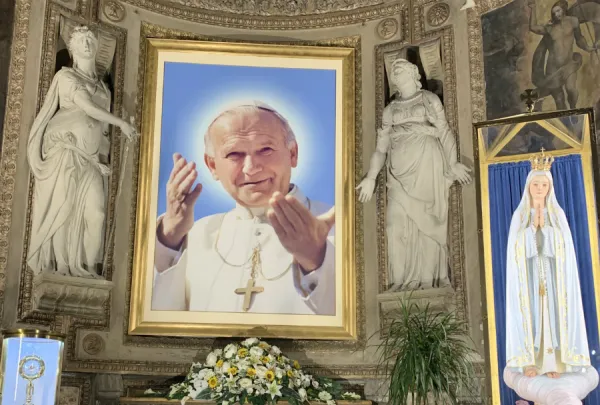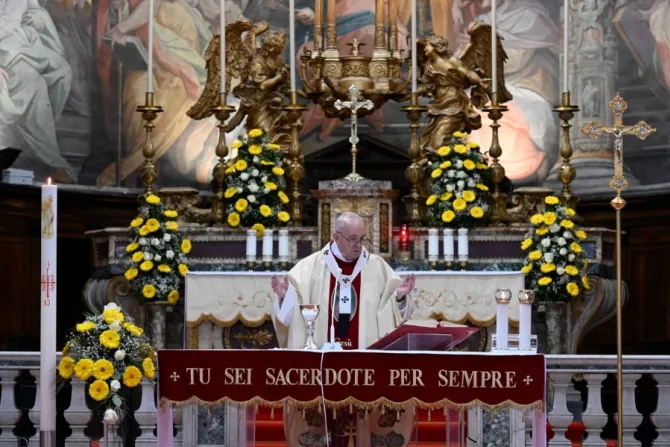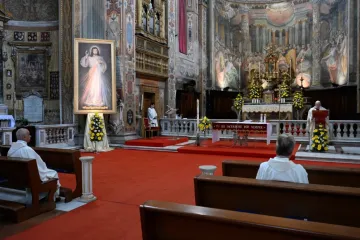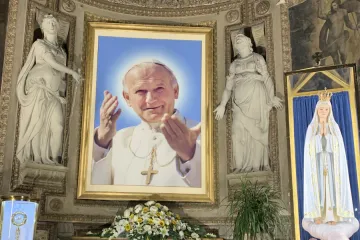Vatican City, Apr 8, 2021 / 08:00 am
On Divine Mercy Sunday, Pope Francis will offer Mass in a church containing the relics of both St. Faustina Kowalska and St. John Paul II.
This will be the second year that the pope has chosen to offer Mass in the church, Santo Spirito in Sassia, which was transformed into a center for Divine Mercy spirituality.
Pope Francis’ Divine Mercy Sunday Mass on April 11 will not be open to the public but will be broadcast on television and via live stream at 10:30 a.m. local time.
Following Mass, Pope Francis will recite the Regina Coeli prayer from inside the church.
Located near St. Peter’s Basilica, Santo Spirito in Sassia is Rome’s official Divine Mercy church. Before the coronavirus epidemic, people gathered each day there at 3 p.m. to pray the Divine Mercy Chaplet.
"At the hour of Divine Mercy … truly the church is filled with many souls -- the young, the sick, couples, and people facing great difficulties of a moral nature who come to implore the Divine Mercy," Msgr. Jozef Bart, the church’s rector previously told CNA.
The Polish priest was personally selected by Pope John Paul II to transform the 16th-century church, originally built as a hospital chapel, into a center for Divine Mercy spirituality in 1994.

When John Paul II visited the church on Divine Mercy Sunday in 1995, he highlighted the church’s role as a place of both spiritual and physical healing throughout history.
“Today in particular, I am pleased to be able to give thanks to God in this Church of Santo Spirito in Sassia, attached to the hospital of the same name, and now a specialized center for the pastoral care of the sick, as well as for the promotion of the spirituality of Divine Mercy," John Paul II said.
“It is very significant and timely that precisely here, next to this very ancient hospital, prayers are said and work is done with constant care for the health of body and spirit,” he said of the church.
The Sisters of Our Lady of Mercy, the order to which St. Faustina belonged, help to lead the daily prayers and catechesis on the Divine Mercy in Santo Spirito in Sassia.
“Jesus told St. Faustina, ‘Man does not find any peace until he turns with faith to the Divine Mercy,’” Msgr. Bart said.
“We priests must remember that we are channels, instruments of the Divine Mercy,” he added.

At the pope’s Mass at Santo Spirito in Sassia last year, Francis recalled that St. Faustina wrote in her diary in 1937 that “In a soul that is suffering we should see Jesus on the cross, not a parasite and a burden... [Lord] you give us the chance to practice deeds of mercy, and we practice making judgments.”
(Story continues below)
Pope Francis said: “Today, in this church that has become a shrine of mercy in Rome, and on this Sunday that St. John Paul II dedicated to Divine Mercy 20 years ago, we confidently welcome this message. Jesus said to St. Faustina: ‘I am love and mercy itself; there is no human misery that could measure up to my mercy’.”





